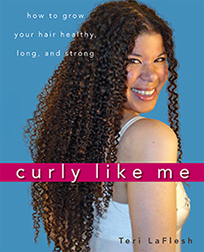
Available now!
Curly Like Me, the off-the-grid, do-it yourself owner's manual for tightly curly hair, is ready for ordering. Grab your copy today!

Every purchase made from
this site (through Amazon)
helps support it — and it
doesn't cost you anything
extra.
|
|
In the ingredient descriptions: Good means that I like to see this in a product's list of ingredients. Okay means this product appears safe for a curly person like me to use. Caution means that this ingredient may not be good in some hair care products, or for some people. Avoid means this ingredient may hurt your hair. If you see this ingredient in a hair product, it's best to put it down and walk away.
|
|
| |
Dimethicone
(aka Linear Polydimethylsiloxanes; Linear PDMS; Dimethyl silicone)
Good
This is the name for a group of silicones. The heaviest of all silicones used for hair care, they provide the most smoothing effect, but is hardest to wash out. Also might be considered too heavy for less curly hair [Beauty Brains pg 38 and provided link]. Conditions by preventing water loss. Also used to keep a product from foaming. Used in a huge amount of products, from hair conditioners to makeup [Gottschalck pg 562]. Gives a velvety feel. This does not evaporate [Schueller pgs 174-178]. Dimethicones are considered nonirritating to the skin and eyes. The different grades of Dimethicones come in different thicknesses, ranging from ones that will quickly evaporate (Hexamethyldisiloxane), to the consistency of honey, to those thicker than silly putty [Schueller pgs 174-178, Hunting (Conditioning) pgs181-182]. Though they are thick, they still allow the surface they are on to "breathe", meaning that water evaporation still occurs through it, so they aren't very moisturizing [Hunting (Conditioning) pg 181-182]. Makes product slippery so comb (or Denman) glides more easily through your curls. —T
This is in one of my favorite, go to conditioners that I've been using for well over ten years. It has not caused any problems as far as conditioning and defining my hair. That's why I'm calling it a
* * * Tried and true ingredient * * *
See also:
Silicone
Source(s):
Gottschalck Beauty Brains Schueller Hunting http://www.theBeautyBrains.com http://clicks.aweber.com/y/ct/?l=DULo7&m=IsGc6lRxjJPguz&b=WQE7LVCT7u7x1K1bpcFv9A
|
|
References:
Applewhite, Thomas H., ed. Proceedings of the World Conference on Lauric Oils: Sources, Processing, and Applications
AOCS Publishing, 1994.
Barel, André O., Marc Paye, and Howard I. Maibach., eds. Handbook of Cosmetic Science and Technology, Second Edition
Marcel Dekker, Inc., 2001.
Begoun, Paula. Don’t Go Shopping for Hair-Care Products Without Me. 3rd Edition.
Renton: Beginning Press, 2005.
Begoun, Paula. The Beauty Bible.
Renton: Beginning Press, 2002.
Begoun, Paula. Don’t Go to the Cosmetics Counter Without Me.
Renton: Beginning Press, 2003.
Bellum, Sarah, ed. The Beauty Brains: Real Scientists Answer Your Beauty Questions
New York: Brains Publishing, 2008.
Gottschalk, Tari E. and McEwen, Gerald N, Jr. PhD, eds. International Cosmetic Ingredient Dictionary and Handbook, Tenth Edition 2004, Volumes 1-4.
Washington D. C.: The Cosmetic, Toiletry, and Fragance Association, 2004.
Halal, John Hair Structure and Chemistry Simplified, Fifth Edition
Albany: Milady, 2002.
Hunting, Anthony L.L. Encyclopedia of Conditioning Rinse Ingredients.
Cranford, NJ: Micelle Press, Inc., 1987.
Hunting, Anthony L.L. Encyclopedia of Shampoo Ingredients.
Cranford, NJ: Micelle Press, Inc., 1983.
Johnson, Dale H. (Ed.). Hair and Hair Care, Cosmetic Science and Technology Series. Vol. 17.
New York: Marcel Dekker, 1997. Print.
Nnanna, Ifendu A. and Jiding Xia., eds. Protein-Based Surfactants: Synthesis: Physicochemical Properties, and Applications (Surfactant Science)
Madison Heights: CRC, 2001.
Quadflieg, Jutta Maria. Fundamental properties of Afro-American hair as related to their straightening/relaxing behaviour.
Diss. U of Rheinisch-Westfälischen Technischen Hochschule Aachen, 2003.
Schueller, Randy and Perry Romanowski, eds. Conditioning Agents for Hair and Skin.
New York: Marcel Dekker, Inc., 1999.
Winter, Ruth M.S. A Consumer's Dictionary of Cosmetic Ingredients: Complete Information About the Harmful and Desirable Ingredients Found in Cosmetics and Cosmeceuticals
New York: Three Rivers Press, 2005.
Zviak, Charles., ed. The Science of Hair Care (Dermatology)
New York: Marcel Dekker, Inc., 1986.
|
|